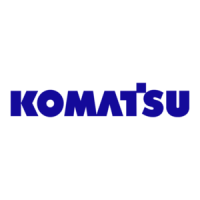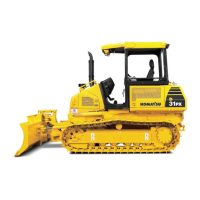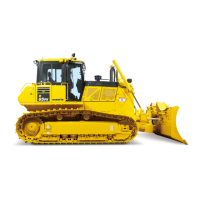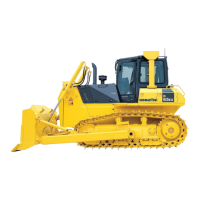Do you have a question about the Komatsu D375A-8 and is the answer not in the manual?
Details operation and maintenance methods for safe machine use. Understand precautions and warnings before operation.
Governs the processing of personal data for operators using Komatsu machines with Machine Monitoring Systems (MMS).
Explains signal words and the Safety Alert Symbol to identify important safety messages in manuals and on machines.
Details machine noise levels affixed on the machine, measured according to ISO 6396.
Specifies vibration levels for earth-moving machines, hands/arms, and body acceleration values as per EN12096.
Covers machine specifications, main uses like dozing, and visibility from the operator's seat.
Explains engine technology using Komatsu Diesel Particulate Filter (KDPF) to conform EPA Tier4 Final emission regulations.
Provides information on product identification numbers (PIN) and machine serial number plates.
Details the components of the serial plate, including machine designation, serial number, and manufacturer.
Declares that the machine fulfills relevant EC Directives, including Machinery and EMC directives.
Guidance on handling warning signs and safety labels, ensuring they are clean, readable, and replaced if damaged.
Covers essential safety rules for operation, inspection, and maintenance to prevent injury or death.
Details safety measures for jobsite conditions, loose ground, high-voltage cables, and visibility.
Outlines safety procedures before starting inspection and maintenance, workplace cleanliness, and personnel safety.
Provides a general overview of the machine, identifying key components like the blade, cab, and ripper.
Explains necessary devices for operating the machine, including the machine monitor and its displays.
Details the basic operation of the machine monitor, including screens displayed when starting the engine.
Explains action level displays (L01-L04) and caution lamps on the machine monitor, indicating machine abnormalities.
Step-by-step guide for performing manual stationary regeneration of the KDPF system to clear soot accumulation.
Instructions on how to disable or stop automatic aftertreatment devices regeneration to prevent fire hazards.
Covers general precautions, starting engine with jumper cables, and switches specific to mining specification machines.
Provides instructions for operating, lowering, storing, and troubleshooting the hydraulic type ladder.
Explains blade states (Single/Dual tilt) and pitch operations (Rearward, Straight, Forward) for effective dozer use.
Suggests optimal working modes (gear shift, operating modes) based on soil conditions and work types.
Details how to switch between Automatic, Manual, and Shoe Slip Control modes for optimal gear selection.
Guidelines for traveling the machine on paved roads, including road surface protection.
Advises observing laws, regulations, and ensuring safety when transporting the machine.
Details the procedure for transporting the machine, considering weight and dimensions.
Provides critical safety warnings and step-by-step procedures for safely loading and unloading the machine.
Outlines safety precautions and procedures for lifting the machine using slings, emphasizing crane operator qualifications.
Provides information on challenges with low temperatures and coolant freezing, and suggests following instructions.
Recommends using low viscosity fuel and oil for all components in cold weather for optimal performance.
Details coolant toxicity, handling precautions, and recommends Non-Amine Engine Coolant (AF-NAC).
Warns about battery hazards including flammable gas, electrolyte dangers, and explosion risks.
Offers crucial advice for preventing machine freezing and damage after daily work in cold conditions.
Provides guidance on actions to take when the weather becomes warmer after the cold season.
Details steps for preparing the machine for storage longer than one month, including cleaning and lubrication.
Explains the essential rust-prevention operation required for machines stored indoors.
Provides instructions for re-using the machine after long-term storage, including pre-use checks.
Covers procedures for restarting the engine after running out of fuel, including bleeding the fuel system.
Provides critical safety warnings and procedures for towing a disabled machine or being towed.
Details safety warnings and procedures for handling and charging discharged batteries to prevent explosion.
Explains correct procedures and warnings for charging a battery to prevent explosion and damage.
Provides step-by-step instructions and safety precautions for starting the engine using jumper cables.
Lists common electrical system problems, their causes, and recommended remedies.
Details chassis-related problems, their causes, and recommended actions for repair.
Covers engine-related issues, their causes, and recommended remedies.
Explains how to interpret warning displays on the machine monitor and take corrective actions.
General precautions before performing any inspection or maintenance not found in this manual.
Instructions to check the service meter daily for upcoming maintenance items.
Provides an overview of maintenance, including recommended parts, oils, fuels, and coolants.
Explains the importance of filters, replacement intervals, and handling precautions.
Lists standard tightening torques for metric nuts and bolts to ensure proper assembly and prevent damage.
Presents a comprehensive schedule for maintenance intervals, from initial 250 hours to 9000 hours.
Details specific maintenance procedures, including initial 250-hour tasks and 'when required' items.
Covers maintenance tasks required every 500 operating hours, including oil and filter changes.
Outlines maintenance tasks required every 1000 operating hours, focusing on power train and hydraulic systems.
Details maintenance tasks for every 2000 operating hours, including hydraulic oil and filter replacements.
Covers maintenance for every 4000 operating hours, such as KDPF cleaning and high-pressure piping checks.
Specifies maintenance tasks required every 4500 hours, including KDPF cleaning and fuel doser cleaning.
Details maintenance for every 8000 hours, focusing on engine high-pressure piping and fuel spray prevention caps.
Covers maintenance tasks required every 9000 hours, including starter motor and alternator overhaul.
Provides guidance on safe dismantling of the machine at the end of its service life.
Lists key specifications for the D375A-8 bulldozer, including weights, engine model, horsepower, and dimensions.
General safety warnings regarding the installation and use of attachments and options not authorized by Komatsu.
Covers general safety practices for attachments, including reading manuals, safe operation, and crane usage.
Guides the selection of appropriate track shoes based on soil conditions to prevent damage and ensure performance.
Provides a systematic procedure for selecting the correct ripper point based on rock type and conditions.
Details the use, installation, and fabrication of external power supply systems for engine preheating.
Explains effective blade operation techniques using Single/Dual tilt and pitch adjustments for various tasks.
Covers operating, lowering, storing, and troubleshooting the hydraulic type ladder, including safety checks.
Provides procedures for temporarily moving the machine to a safe place if it fails to move.
Lists safety and fire prevention parts requiring periodic replacement to ensure machine safety and performance.
Details consumable parts like filters and elements that need replacement at periodic intervals or before wear limits.
Provides recommendations for fuel, coolant, and lubricants, emphasizing Komatsu genuine products.
Advises consulting Komatsu distributors when using commercial oils other than genuine Komatsu oils.
Details operation and maintenance methods for safe machine use. Understand precautions and warnings before operation.
Governs the processing of personal data for operators using Komatsu machines with Machine Monitoring Systems (MMS).
Explains signal words and the Safety Alert Symbol to identify important safety messages in manuals and on machines.
Details machine noise levels affixed on the machine, measured according to ISO 6396.
Specifies vibration levels for earth-moving machines, hands/arms, and body acceleration values as per EN12096.
Covers machine specifications, main uses like dozing, and visibility from the operator's seat.
Explains engine technology using Komatsu Diesel Particulate Filter (KDPF) to conform EPA Tier4 Final emission regulations.
Provides information on product identification numbers (PIN) and machine serial number plates.
Details the components of the serial plate, including machine designation, serial number, and manufacturer.
Declares that the machine fulfills relevant EC Directives, including Machinery and EMC directives.
Guidance on handling warning signs and safety labels, ensuring they are clean, readable, and replaced if damaged.
Covers essential safety rules for operation, inspection, and maintenance to prevent injury or death.
Details safety measures for jobsite conditions, loose ground, high-voltage cables, and visibility.
Outlines safety procedures before starting inspection and maintenance, workplace cleanliness, and personnel safety.
Provides a general overview of the machine, identifying key components like the blade, cab, and ripper.
Explains necessary devices for operating the machine, including the machine monitor and its displays.
Details the basic operation of the machine monitor, including screens displayed when starting the engine.
Explains action level displays (L01-L04) and caution lamps on the machine monitor, indicating machine abnormalities.
Step-by-step guide for performing manual stationary regeneration of the KDPF system to clear soot accumulation.
Instructions on how to disable or stop automatic aftertreatment devices regeneration to prevent fire hazards.
Covers general precautions, starting engine with jumper cables, and switches specific to mining specification machines.
Provides instructions for operating, lowering, storing, and troubleshooting the hydraulic type ladder.
Explains blade states (Single/Dual tilt) and pitch operations (Rearward, Straight, Forward) for effective dozer use.
Suggests optimal working modes (gear shift, operating modes) based on soil conditions and work types.
Details how to switch between Automatic, Manual, and Shoe Slip Control modes for optimal gear selection.
Guidelines for traveling the machine on paved roads, including road surface protection.
Advises observing laws, regulations, and ensuring safety when transporting the machine.
Details the procedure for transporting the machine, considering weight and dimensions.
Provides critical safety warnings and step-by-step procedures for safely loading and unloading the machine.
Outlines safety precautions and procedures for lifting the machine using slings, emphasizing crane operator qualifications.
Provides information on challenges with low temperatures and coolant freezing, and suggests following instructions.
Recommends using low viscosity fuel and oil for all components in cold weather for optimal performance.
Details coolant toxicity, handling precautions, and recommends Non-Amine Engine Coolant (AF-NAC).
Warns about battery hazards including flammable gas, electrolyte dangers, and explosion risks.
Offers crucial advice for preventing machine freezing and damage after daily work in cold conditions.
Provides guidance on actions to take when the weather becomes warmer after the cold season.
Details steps for preparing the machine for storage longer than one month, including cleaning and lubrication.
Explains the essential rust-prevention operation required for machines stored indoors.
Provides instructions for re-using the machine after long-term storage, including pre-use checks.
Covers procedures for restarting the engine after running out of fuel, including bleeding the fuel system.
Provides critical safety warnings and procedures for towing a disabled machine or being towed.
Details safety warnings and procedures for handling and charging discharged batteries to prevent explosion.
Explains correct procedures and warnings for charging a battery to prevent explosion and damage.
Provides step-by-step instructions and safety precautions for starting the engine using jumper cables.
Lists common electrical system problems, their causes, and recommended remedies.
Details chassis-related problems, their causes, and recommended actions for repair.
Covers engine-related issues, their causes, and recommended remedies.
Explains how to interpret warning displays on the machine monitor and take corrective actions.
General precautions before performing any inspection or maintenance not found in this manual.
Instructions to check the service meter daily for upcoming maintenance items.
Provides an overview of maintenance, including recommended parts, oils, fuels, and coolants.
Explains the importance of filters, replacement intervals, and handling precautions.
Lists standard tightening torques for metric nuts and bolts to ensure proper assembly and prevent damage.
Presents a comprehensive schedule for maintenance intervals, from initial 250 hours to 9000 hours.
Details specific maintenance procedures, including initial 250-hour tasks and 'when required' items.
Covers maintenance tasks required every 500 operating hours, including oil and filter changes.
Outlines maintenance tasks required every 1000 operating hours, focusing on power train and hydraulic systems.
Details maintenance tasks for every 2000 operating hours, including hydraulic oil and filter replacements.
Covers maintenance for every 4000 operating hours, such as KDPF cleaning and high-pressure piping checks.
Specifies maintenance tasks required every 4500 hours, including KDPF cleaning and fuel doser cleaning.
Details maintenance for every 8000 hours, focusing on engine high-pressure piping and fuel spray prevention caps.
Covers maintenance tasks required every 9000 hours, including starter motor and alternator overhaul.
Provides guidance on safe dismantling of the machine at the end of its service life.
Lists key specifications for the D375A-8 bulldozer, including weights, engine model, horsepower, and dimensions.
General safety warnings regarding the installation and use of attachments and options not authorized by Komatsu.
Covers general safety practices for attachments, including reading manuals, safe operation, and crane usage.
Guides the selection of appropriate track shoes based on soil conditions to prevent damage and ensure performance.
Provides a systematic procedure for selecting the correct ripper point based on rock type and conditions.
Details the use, installation, and fabrication of external power supply systems for engine preheating.
Explains effective blade operation techniques using Single/Dual tilt and pitch adjustments for various tasks.
Covers operating, lowering, storing, and troubleshooting the hydraulic type ladder, including safety checks.
Provides procedures for temporarily moving the machine to a safe place if it fails to move.
Lists safety and fire prevention parts requiring periodic replacement to ensure machine safety and performance.
Details consumable parts like filters and elements that need replacement at periodic intervals or before wear limits.
Provides recommendations for fuel, coolant, and lubricants, emphasizing Komatsu genuine products.
Advises consulting Komatsu distributors when using commercial oils other than genuine Komatsu oils.
| Engine Model | Komatsu SAA6D170E-7 |
|---|---|
| Number of Forward Gears | 3 |
| Number of Reverse Gears | 3 |
| Gross Power | 257 kW |
| Net Horsepower | 468 hp |
| Blade Width | 3, 700 mm |
| Blade Capacity | 12.5 m³ |
| Track Gauge | 2, 540 mm |
| Track Length | 3, 600 mm |












